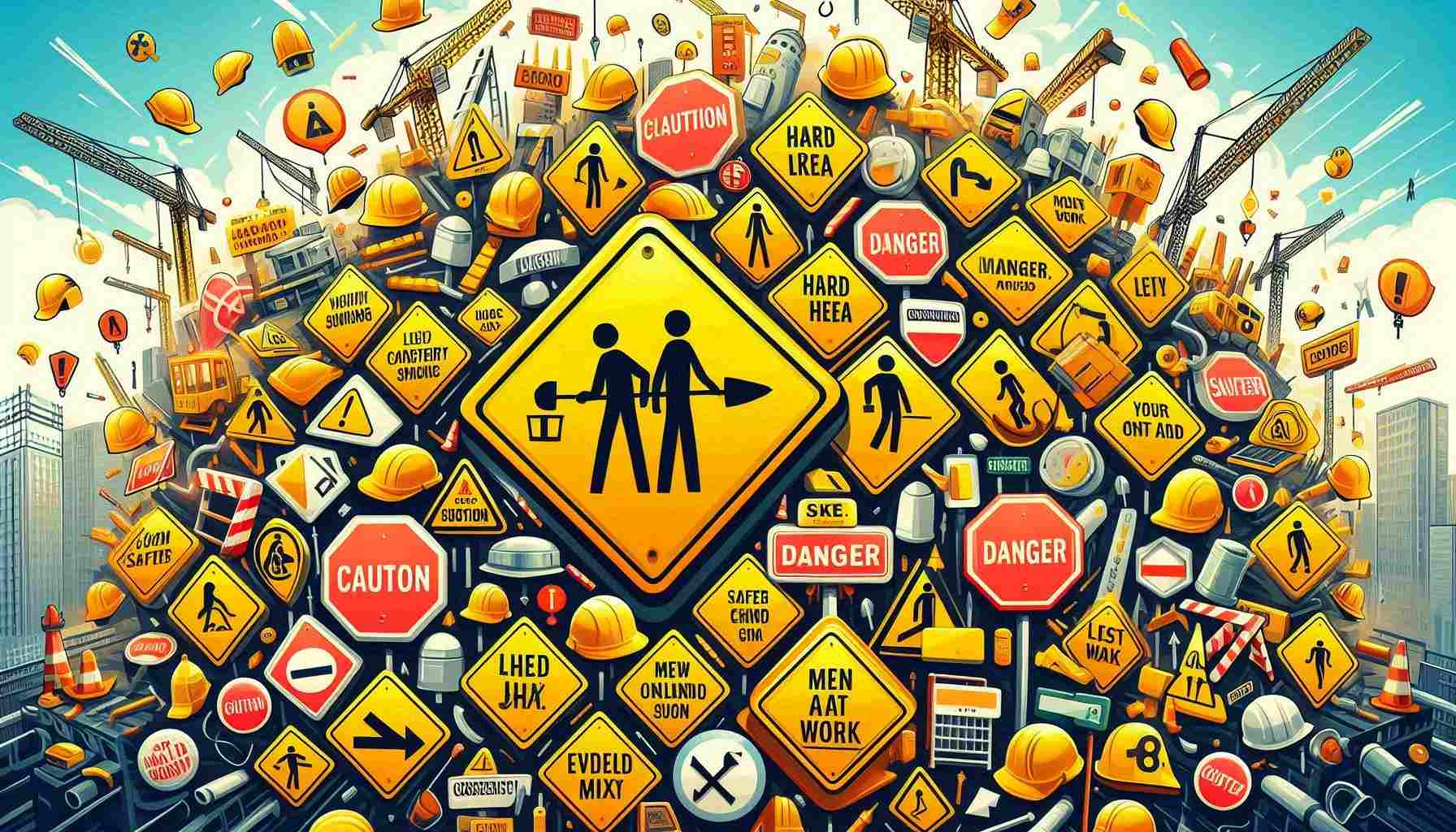Ever walked past a construction site and noticed those bright, eye-catching signs? They’re not just there to look pretty! Construction signs are the unsung heroes of job sites, silently keeping workers and passersby safe while ensuring smooth operations. As the old saying goes, “An ounce of prevention is worth a pound of cure,” and nowhere is this truer than in the world of construction.
Construction sites are bustling hubs of activity, with heavy machinery, potential hazards, and a constant flow of workers and materials. In this dynamic environment, clear communication is absolutely crucial. That’s where construction signs come in, acting as silent sentinels that guide, warn, and inform everyone on and around the site.
Key Takeaways
- Construction signs are essential for maintaining safety and facilitating communication on job sites.
- They come in various types, including warning, regulatory, informational, and directional signs.
- Proper placement and maintenance of signs is crucial for their effectiveness.
- Signs must comply with OSHA standards and local regulations.
- Regular training and updates on sign meanings are important for all site personnel.
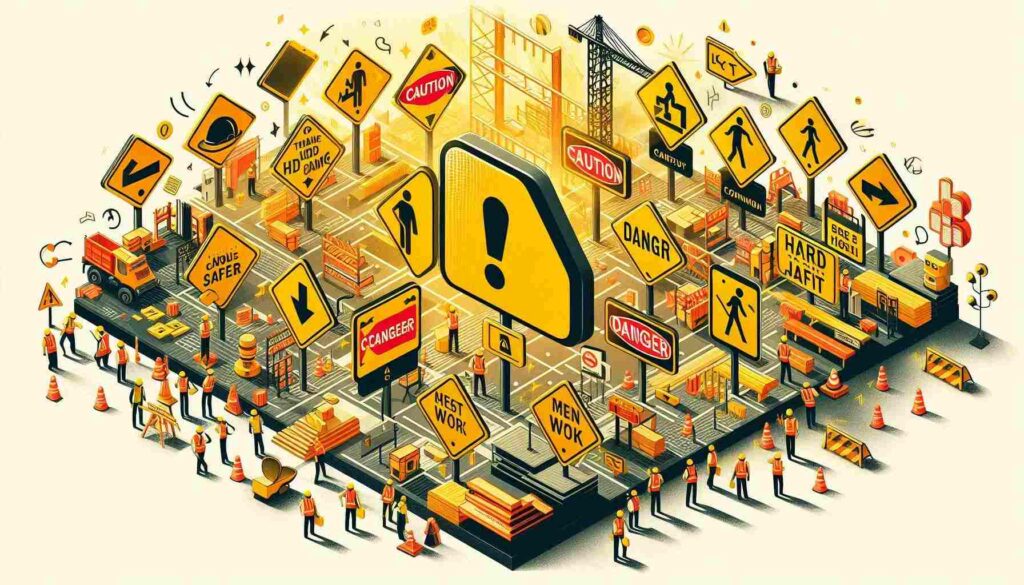
Understanding Construction Signs: More Than Just Pretty Pictures
Construction signs are visual aids designed to convey important information quickly and effectively in a construction environment. They use a combination of colors, symbols, and text to communicate various messages, from potential dangers to required actions. These signs are the silent guardians of the construction world, tirelessly working to keep everyone safe and informed.
I remember my first day on a construction site – it was like entering a whole new world! The cacophony of machinery, the buzz of activity, and everywhere I looked, there were signs. Red ones, yellow ones, some with weird symbols I’d never seen before. It was overwhelming at first, but I quickly realized how important they were for keeping me and everyone else out of harm’s way.
Types of Construction Signs: A Rainbow of Safety
Construction signs come in all shapes, sizes, and colors, each with its own specific purpose. Let’s break down the main types you’ll encounter on a typical job site:
Warning Signs
These are the attention-grabbers, usually sporting a bold yellow background with black text. They’re designed to alert workers and visitors to potential hazards. Common examples include “Caution: Falling Objects” or “Warning: High Voltage.” I’ll never forget the time I almost walked into an area with live electrical work – thank goodness for that bright yellow sign that stopped me in my tracks!
Regulatory Signs
These signs are all about rules and requirements. They’re typically white with black text and often include a red circle with a slash for prohibited actions. You’ll see signs like “No Smoking” or “Hard Hat Required” in this category. They’re not just suggestions – ignoring these signs can lead to serious consequences, both in terms of safety and job site discipline.
Informational Signs
These helpful signs provide important details about the site or specific areas. They might indicate the location of first aid kits, emergency exits, or assembly points. Blue is often used for these signs, making them easy to spot. On my last project, we had a great system of informational signs that made it super easy for new workers and visitors to find their way around.
Directional Signs
As the name suggests, these signs help guide people around the site. They might indicate pedestrian walkways, vehicle routes, or the location of specific work areas. Green is commonly used for these signs, symbolizing “go” or “this way.” Trust me, on a large construction site, good directional signage can save you a lot of time and frustration!
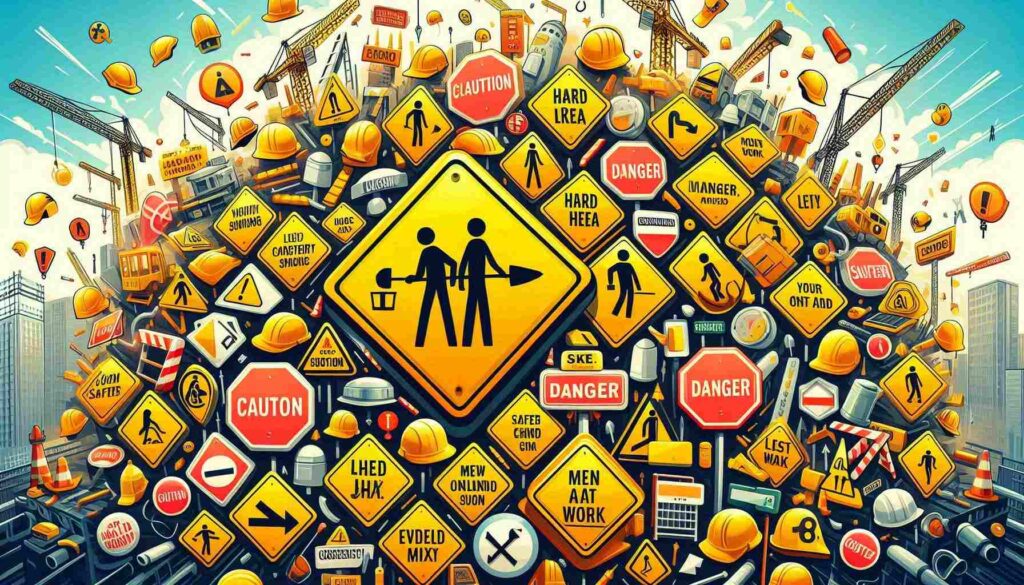
The Importance of Proper Sign Placement
Having the right signs is only half the battle – placing them correctly is equally crucial. Signs should be positioned where they’re easily visible and at a height that’s comfortable for reading. They should also be placed far enough in advance of hazards or decision points to give people time to react.
I once worked on a site where a critical warning sign was partially obscured by some equipment. It was a disaster waiting to happen! We quickly realized the mistake and repositioned it, but it was a stark reminder of how important proper placement is.
Here are some key considerations for sign placement:
- Visibility: Ensure signs are not blocked by equipment, materials, or other obstructions.
- Lighting: In areas with poor lighting, consider using reflective signs or providing additional illumination.
- Distance: Place signs far enough away from hazards to allow for adequate response time.
- Height: Install signs at eye level when possible, or at an appropriate height for the viewing distance.
- Consistency: Use a consistent approach to sign placement across the site for easier recognition.
Maintaining and Updating Signs: Keep ‘Em Fresh!
Construction sites are dynamic environments, with conditions changing frequently. It’s crucial to regularly inspect and maintain signs to ensure they remain effective. This includes cleaning dirty signs, replacing damaged ones, and updating information as needed.
I’ve seen signs that were so faded or damaged that they were practically useless. It’s not just about having signs – it’s about having signs that actually do their job. Regular maintenance should be part of every site’s safety protocol.
As we continue to explore the world of construction signs, we’ll delve into the regulations governing their use, the psychology behind effective sign design, and some real-world examples of how proper signage has prevented accidents and improved site efficiency…
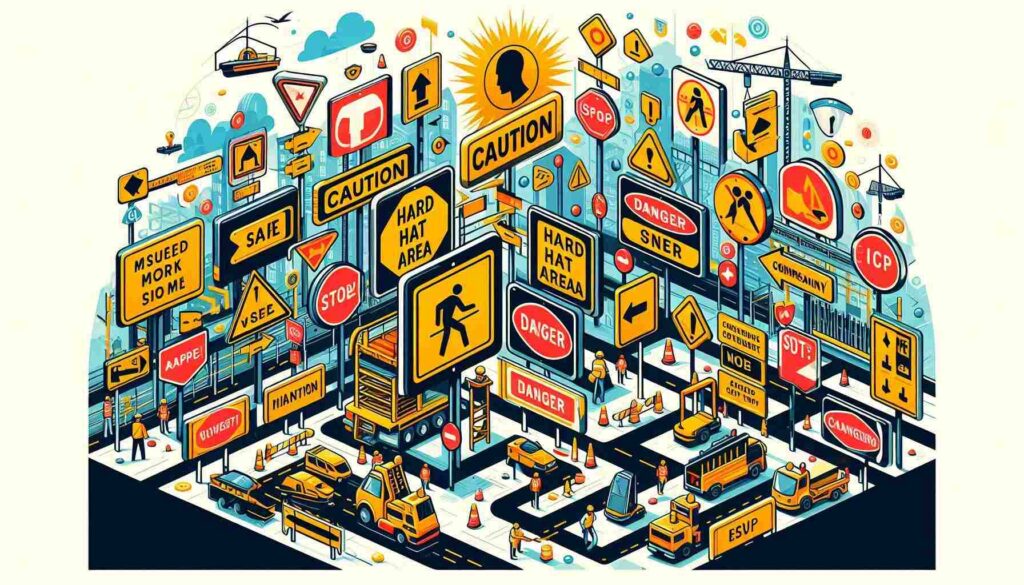
The Psychology Behind Effective Sign Design
Ever wondered why some signs grab your attention while others fade into the background? It’s not just random chance – there’s a whole science behind effective sign design. Color psychology plays a huge role. Red screams “danger!” while green says “all clear.” And don’t even get me started on fonts! Bold, clear typefaces are a must for quick readability.
I once worked on a site where we switched from text-heavy signs to ones with simple icons. The difference was night and day! Suddenly, everyone – even the non-English speakers – could understand the messages at a glance. It was a real eye-opener about the power of visual communication.
Some key elements of effective sign design include:
- High contrast between text and background
- Use of universally recognized symbols
- Concise, clear messaging
- Appropriate size for viewing distance
- Durability to withstand site conditions
Regulations and Standards: Staying on the Right Side of the Law
Navigating the world of construction sign regulations can feel like trying to read a map in a sandstorm. But trust me, it’s crucial to get it right. In the US, the Occupational Safety and Health Administration (OSHA) sets the standards for construction site signage. And let me tell you, they don’t mess around!
I remember a site inspection where we got dinged for having a few outdated signs. It was a wake-up call about the importance of staying current with regulations. Now, I make it a point to review our signage regularly against the latest OSHA guidelines.
Key regulatory considerations include:
- Compliance with OSHA standards for design and placement
- Adherence to ANSI Z535 standards for safety signs and colors
- Regular updates to reflect changes in regulations
- Documentation of sign placement and maintenance
- Training for workers on sign meanings and importance
Real-World Impact: When Signs Save the Day
Let’s get real for a moment – these signs aren’t just for show. They can literally be the difference between a normal day at work and a tragedy. I’ve seen it firsthand. On one project, a well-placed “Watch for Falling Objects” sign prevented a nasty accident when some materials were accidentally dropped from a higher level.
But it’s not just about preventing accidents. Good signage can seriously boost efficiency too. I worked on a site where we implemented a color-coded directional system for different trades. The reduction in time wasted by lost workers or misdelivered materials was astounding!
Some notable impacts of effective signage:
- Reduced accident rates
- Improved site navigation and efficiency
- Enhanced communication between different teams
- Increased awareness of potential hazards
- Better compliance with safety protocols
The Future of Construction Signs: High-Tech Safety
Exciting times are ahead in the world of construction signage! We’re seeing some really cool innovations that are taking safety to the next level. Digital signs that can be updated remotely? Yep, that’s a thing now. And how about signs with built-in sensors that can detect and warn about changing conditions? Mind-blowing stuff!
I recently visited a site that was trialing augmented reality safety information. Workers could use their phones to scan QR codes on signs and get detailed safety briefings specific to that area. It was like something out of a sci-fi movie!
Some emerging trends in construction signage include:
- Smart signs with real-time updates
- Integration with wearable safety technology
- Multilingual and audio-enabled signs for increased accessibility
- Use of photoluminescent materials for better visibility in low light
- AI-powered systems for optimal sign placement and monitoring
As we’ve explored, construction signs are far more than just colorful decorations on a job site. They’re vital tools for communication, safety, and efficiency. From the psychology of design to the latest high-tech innovations, every aspect of these silent guardians plays a crucial role in keeping our construction sites safe and productive.
Remember, a well-signed site is a safer site. So next time you’re walking past a construction zone, take a moment to appreciate those hardworking signs. They might just be saving lives!
Frequently Asked Questions
1. Why are construction signs important?
Construction signs are crucial for maintaining safety and facilitating communication on job sites. They warn of potential hazards, provide important information, and guide workers and visitors around the site. Proper signage can prevent accidents, improve efficiency, and ensure compliance with safety regulations.
2. What are the main types of construction signs?
The main types of construction signs include warning signs (yellow, alerting to potential dangers), regulatory signs (white, indicating rules and requirements), informational signs (blue, providing site details), and directional signs (green, guiding movement around the site). Each type serves a specific purpose in maintaining site safety and organization.
3. How often should construction signs be inspected and maintained?
Construction signs should be inspected regularly, ideally as part of daily site walkthroughs. Maintenance should be performed as needed, which might include cleaning dirty signs, replacing damaged ones, or updating information. It’s also important to review signage whenever site conditions change or new hazards are identified.
4. What regulations govern construction site signage?
In the United States, the Occupational Safety and Health Administration (OSHA) sets standards for construction site signage. These regulations cover aspects such as sign design, placement, and content. Additionally, the American National Standards Institute (ANSI) provides guidelines for safety signs and colors. Local building codes may also have specific requirements for construction signage.
5. How can I ensure my construction signs are effective?
To ensure effectiveness, construction signs should be clearly visible, easily readable, and properly placed. Use high-contrast colors and simple, recognizable symbols. Place signs where they’ll be seen before the hazard or information point. Regularly train workers on the meanings of different signs and the importance of following them. Also, consider the diversity of your workforce and use multilingual signs if necessary.
6. What’s the difference between temporary and permanent construction signs?
Temporary signs are used during the construction process and are typically movable or easily removable. They might indicate short-term hazards or provide information relevant to the current phase of construction. Permanent signs are installed as part of the finished structure and provide ongoing safety information or directions. Both types are important for maintaining safety throughout the life of a project and beyond.
7. Can digital signs be used on construction sites?
Yes, digital signs are becoming increasingly common on construction sites. They offer advantages such as real-time updates, the ability to display multiple messages, and improved visibility in low-light conditions. However, they require power sources and may need protection from the elements. It’s important to ensure that any digital signs meet the same regulatory requirements as traditional signs.
8. How do I choose the right size for my construction signs?
The size of construction signs depends on factors such as viewing distance, amount of information to be conveyed, and site conditions. OSHA provides guidelines for minimum sign sizes based on viewing distance. As a general rule, signs should be large enough to be easily read from the intended viewing distance, but not so large as to be obtrusive or create a hazard themselves.
9. What should I do if I notice a missing or damaged sign on a construction site?
If you notice a missing or damaged sign, report it immediately to the site supervisor or safety officer. Don’t attempt to fix or replace the sign yourself unless you’re authorized to do so. In the meantime, if the missing sign was warning of a hazard, take steps to alert others to the danger if it’s safe for you to do so.
10. Are there any new technologies being used in construction signage?
Yes, several new technologies are being incorporated into construction signage. These include smart signs that can update based on changing conditions, augmented reality systems that provide additional information when signs are scanned, and integration with wearable safety devices. Some sites are also experimenting with signs made from photoluminescent materials for improved visibility in low light conditions.

